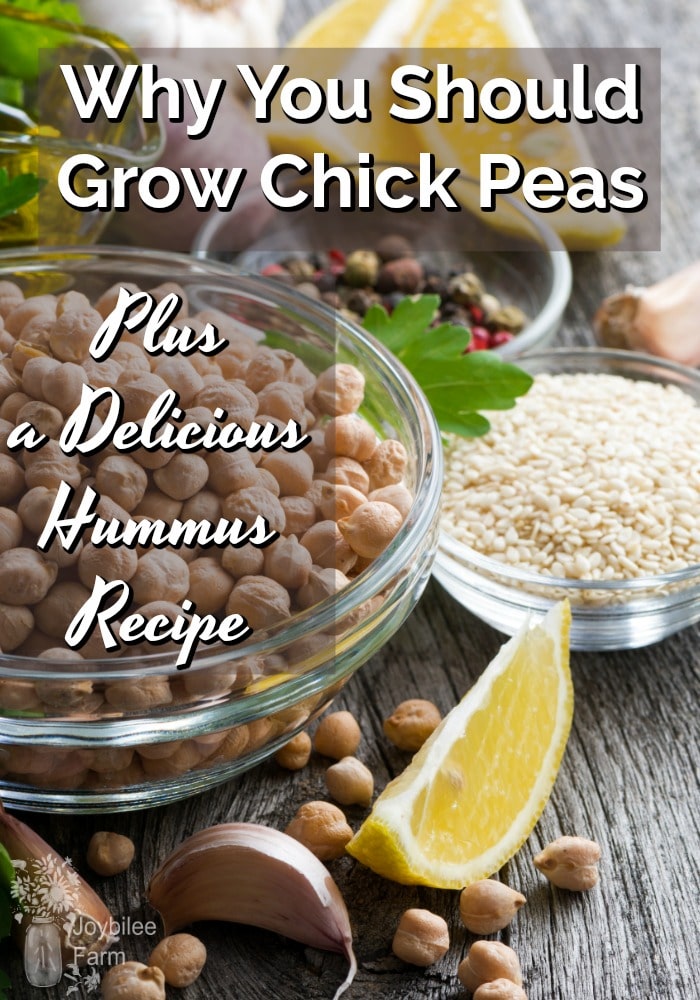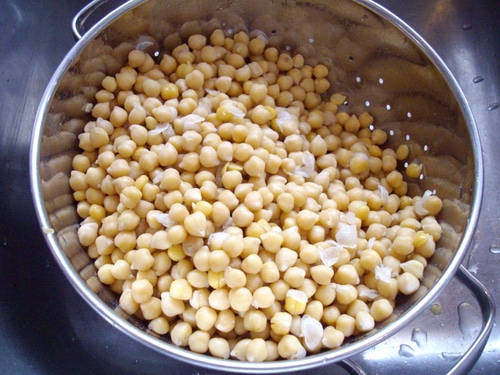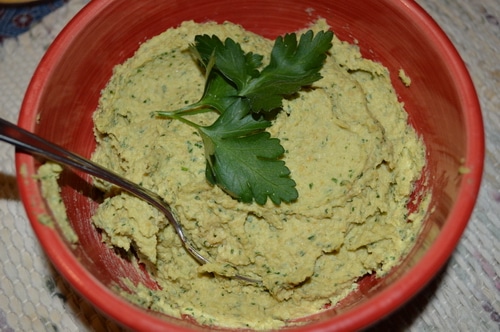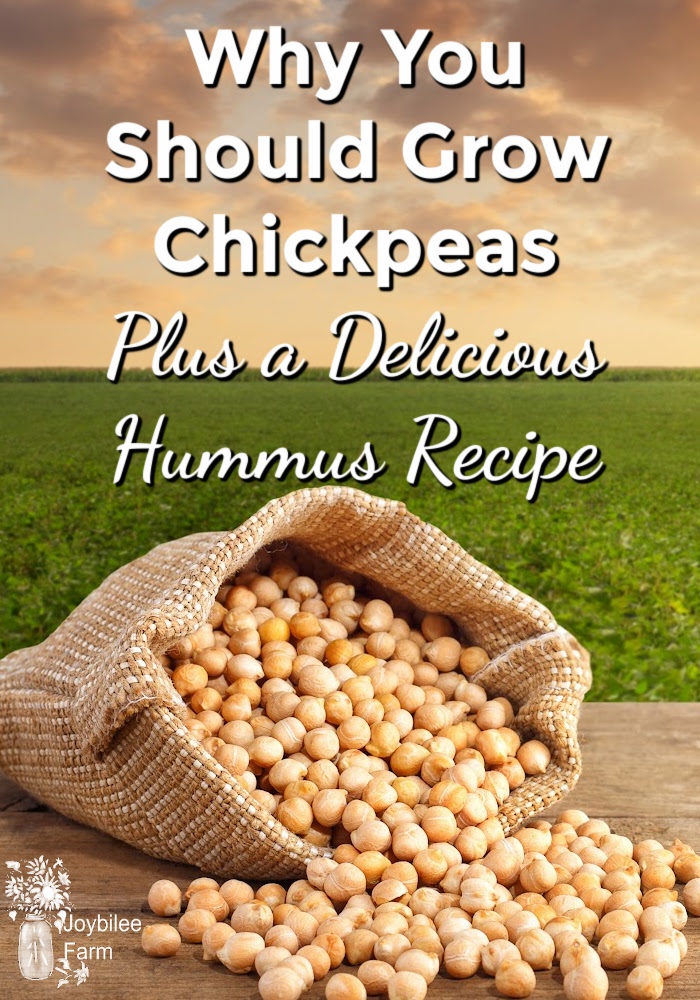Chickpeas and Hummus for homestead self-reliance
You should grow chickpeas for their nutritional value and because they’re a good choice for homestead self-reliance. I’ve also included my delicious Hummus recipe for you to enjoy.

Chickpeas or Garbanzo Beans are a traditional part of the Mediterranean and Indian diet. They are rich in fibre, with 20% crude protein. Sally Fallon in Nourishing Traditions says of the Garbanzo Bean,
“They are one of the most nutritious of all the legumes, high in calcium, phosphorus, and potassium. They have an exceptionally high iron and vitamin C content and contain B complex as well. Like all pulses, they are rich in essential fatty acids. However as Chickpeas are high in omega 6 fatty acids, they should not be consumed to excess.” Sally Fallon, p. 477.
Growing your own chickpeas is easier in a cooler climate than growing other beans and their high protein content makes them a good choice for homestead self-reliance.
Growing Chickpeas/Garbanzo Beans
Chickpeas or Garbanzo Beans are neither a pea nor a bean. They are classed as legumes and are similar to vetch in growth patterns. Chickpeas are the world’s third most important pulse crop, after dried beans and peas, making up 20% of the world’s pulse production. There are two main varieties of chickpeas — the Kabuli chickpea needs more warmth and a longer growing season and is the large, creamy coloured chickpea that is most commonly found in the grocery store, and canned beans. The Desi chickpea needs less heat, will germinate in cooler soils and is matured sooner in the field. The desi variety is the smaller, dark brown chickpea found in East Indian markets. It is commonly used for chickpea flour and has a high oil content.
The Kabuli chickpea takes 100 days from planting to harvest in an ideal climate. It doesn’t take transplanting well, due to its long taproot. It should be planted about 2 weeks before the expected last frost date in your zone — about May 1st in my area. The Desi chickpea can be planted earlier, about the same time that I plant peas and linen/flax. It is more frost-hardy and matures sooner than Kabuli. The chickpeas are formed in pods that hold one to two seeds each. The plants begin to flower about 50 days after emergence. Kabuli flowers are white, while desi flowers are purple to pink. The plant looks similar to vetch before flowering. The plant does better in areas that have a drought in the late summer, as the drought stress promotes maturity.
Growing Chickpeas
Chickpea is a cool season plant usually grown as a winter crop in India, the Middle East, Australia, and South and Central America. It grows best if daytime temperatures are between 21 and 29 degrees Celsius and nighttime temperatures are between 18 and 21 degrees Celsius. The best temperature for germination is 15 degrees Celsius, however desi chickpea, germination can begin when soil temperatures are as low as 5 degrees Celsius. Kabuli chickpea is more sensitive to cold temperatures and should not be seeded into soil colder than 10 degrees Celsius at the placement depth.Seedlings will tolerate light spring frost, but frost damage on immature seeds (especially of kabuli chickpea) will prevent the seeds from turning the desirable golden colour. Chickpea is a relatively drought tolerant crop. The long taproot allows the chickpea plant to use water to a greater depth than other pulse crops. In the absence of disease, chickpea performs best when there is between 8 and 12 inches of rainfall during the growing season, and when cropped on soils that are well drained. — Saskatchewan Pulse Growers
Planting density is 4 plants per square foot. A wider spacing can be detrimental by inhibiting maturity, so plant them close. Keep them well weeded. Don’t add nitrogen-rich manure composts to the soil during growing, as this will encourage leaf formation to the detriment of seed formation. Adding some ashes to the soil before planting will encourage flowering and fruiting. Side dressing with finished compost at the time of flowering can increase yields.
Pick your peas once the leaves have turned brown. Either allow the peas to dry on the plant or harvest the pods and continue drying undercover.
Once they are completely dry, store them in jars as you would other dried beans.

Preparing Chickpeas the traditional way
Chickpeas, like other seeds and beans, contain phytates, anti-nutrients that discourage pests from consuming them. Phytates or phytic acid combines with iron, calcium, phosphorus, and zinc in the intestinal tract so that these minerals cannot be absorbed. Traditional societies usually soak or ferment their beans before eating them, a process that neutralizes the phytic acid. Proper preparation techniques also help in the breakdown of complex sugars in legumes, making them more digestible. For this reason, avoid canned chickpeas and soak dried chickpeas overnight before cooking. After soaking rinse them well, and with fresh water, cook them until they are almost soft. Rinse again. This should remove the majority of the phytates.
One further step is necessary for chickpea cooking. The skins on the chickpeas contain still more phytic acid. Traditionally the skins were removed when the peas were almost cooked, but not quite. Remove the skins by immersing the almost cooked peas in cold water. While underwater, rub the peas between your hands. The skins will slip off and float just below the surface of the water, where they can be scooped away.
Add fresh water and continue cooking until soft.


Hummus Recipe
Description
A delicious and healthy snack with pita, crackers or veggies.
Ingredients
- 2 garlic cloves
- 2 tablespoons toasted sesame oil (optional)
- 3 cups of cooked chickpeas
- 1 lemon, zested and juiced
- 1/2 cup sunflower seeds, lightly toasted in coconut oil
- Chopped green onions, chives, or parsley
Instructions
- Blend garlic, chickpeas, zest of 1 lemon, lemon juice in a food processor or blender, until smooth
- Add water from the cooked beans if necessary to get a smooth paste
- Add chopped green onions, parsley, or chives just before serving
Notes
Serve with warm pita bread, crackers or fresh cut vegetables.
Joybilee Farm Hummus
2 garlic cloves
2 tbsp. toasted sesame oil (optional)
3 cups of cooked chickpeas
1 lemon, zested and juiced
1/2 cup sunflower seeds, lightly toasted in coconut oil
chopped green onions, chives, or parsley
Blend garlic, chickpeas, zest of 1 lemon, lemon juice in a food processor or blender, until smooth. Add water from the cooked beans if necessary to get a smooth paste. Add chopped green onions, parsley, or chives just before serving.
Serve with warm pita bread or crackers. I love eating this in a dish with a spoon. Way better than peanut butter!

Chickpea Sprouts
You can also enjoy chickpeas as sprouts. Follow the directions in my article on sprouting to get successful sprouts.
Container Growing Chickpeas
The tender young leaves of spring plants can be added to salads and stir-fries. While it doesn’t make sense to grow them in a container for dried pea production, growing chickpeas in a container for greens and sprouts are a very good way to enjoy them if you have limited space. Young sprouts are rich in vitamins and enzymes.
In Mexico, chickpeas are used as animal fodder. Consider them when mixing your own GMO-free livestock protein supplement. Chickpeas have 20% crude protein. Ruminants can do well both on the greens and on the seeds when mixed with other grains like wheat, oats, and barley. The addition of flaxseed or sunflower seed helps to balance the omega 3/6 ratio in the ration.
Back to you:
What’s your experience growing chickpeas? Leave a comment.
My favourite cookbook: Nourishing Traditions: The Cookbook that Challenges Politically Correct Nutrition and the Diet Dictocrats



Leave a Reply